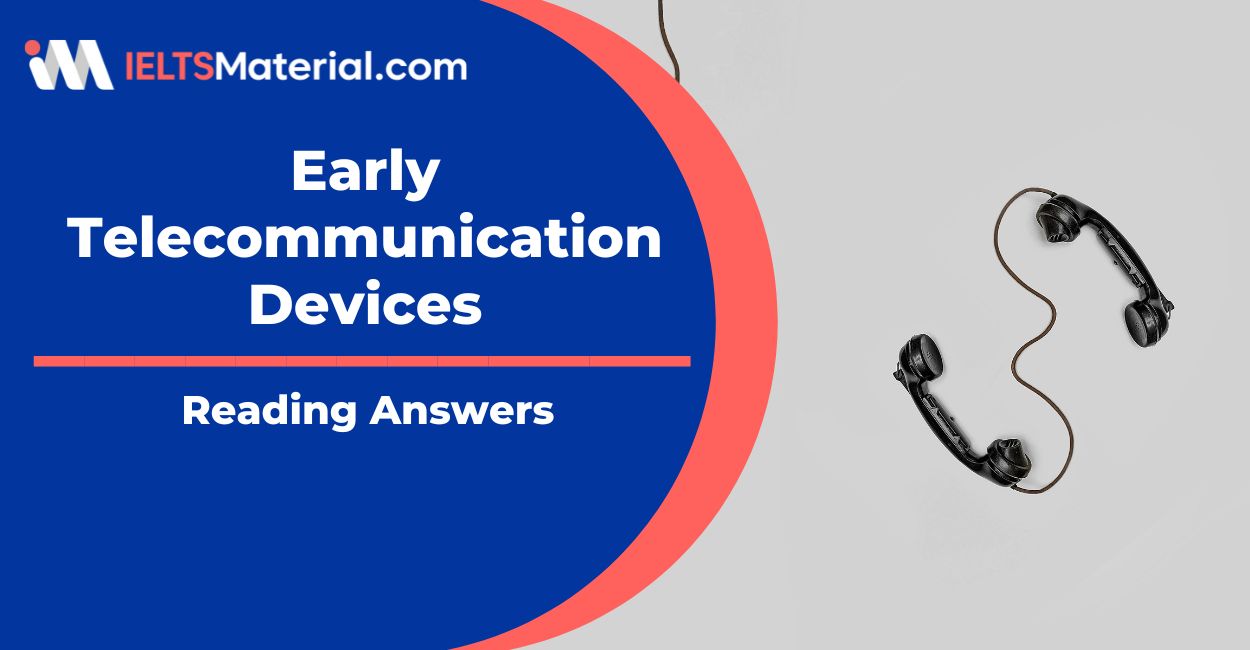Early Telecommunication Devices Reading Answers
2 min read
Updated On
-
Copy link
Table of Contents

Limited-Time Offer : Access a FREE 10-Day IELTS Study Plan!
This article contains the Early Telecommunication Devices reading answers.
Early Telecommunication Devices is a real Reading test passage that appeared in the IELTS.
With diligent practice, the Reading Module can be the top-scoring category for IELTS Aspirants. To score well, you must understand how to approach and answer the different question types in the Reading Module.
By solving and reviewing Sample Reading Questions from past IELTS papers, you can ensure that your Reading skills are up to the mark. Take the practice test Early Telecommunication Devices below and try more IELTS reading practice tests from IELTSMaterial.com.
Not sure how to answer IELTS Reading questions? Check out the video below for the latest tips and strategies!
For more Short Answer Questions practice, take a look at IELTS Reading Short Answer Questions | Example 1!
Early Telecommunication Devices
You should spend about 20 minutes on Questions 1-13, which are based on the Reading Passage below. Find the practice test with the Early Telecommunication Devices PDF here.
Answers
The answers with explanations are given below
| Question Number | Answers | Keywords | Location of Keywords |
|---|---|---|---|
| 1. | Cooke and Wheatstone | William Cook and Charles Wheatstone, patented in England in 1845 | Paragraph A, Lines 7-8 |
| 2. | Western Union Company | In 1851, twelve of these companies come together | Paragraph C, Lines 4-6 |
| 3. | Reis | Phillip Reis, in 1861 that he labelled the telephone | Paragraph D, Lines 4-5 |
| 4. | Telephones | the US patent office for their respective telephones | Paragraph E, Lines 11-12 |
| 5. | Harmonic telegraph | perfected by Thomas Edison, in 1881. | Paragraph E, Last 2 lines |
| 6. | C | the invention of the telephone, a system known as a harmonic telegraph | Paragraph E, Lines 2-5 |
| 7. | A | Patented in England in 1845, British rail companies | Paragraph A, Last 3 lines |
| 8. | E | Edison | Paragraph E, Last 2 lines |
| 9. | D | Western Union, asked Elisha Gray to make refinements | Paragraph F, Lines 4-6 |
| 10. | B | Pacific Union, based on the telephone design of Phillips Reis. | Paragraph G, Lines 13-16 |
| 11. | Awkward to use/ Difficult to transport/ Expensive | Proved to the awkward to use, difficult to transport and expensive to build | Paragraph B, Lines 2-3 |
| 12. | Rail stations | Western Union, telegraph offices, almost all in rail stations. | Paragraph C, Last 2 lines |
| 13. | Musical tones | Reis’s invention, limited to transmitting musical tones, | Paragraph D, Last 2 lines |
| 14. | Harmonic telegraph | Perfection of the harmonic telegraph proved too difficult | Paragraph E, Lines 7-8 |
Check More IELTS Reading Answers
Also check :
Practice IELTS Reading based on question types

Start Preparing for IELTS: Get Your 10-Day Study Plan Today!
Recent Articles

Nehasri Ravishenbagam

Haniya Yashfeen

Haniya Yashfeen

Haniya Yashfeen




Post your Comments